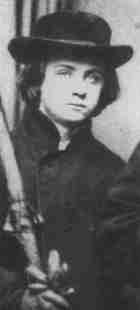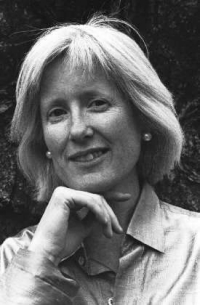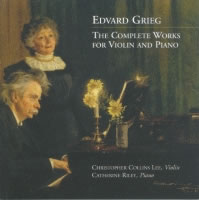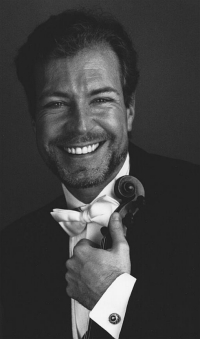| Christopher Collins Lee & Catherine Riley |
Buy this album now CD: £10.00 + p&p |
| Sonata Op. 13 in G Major | ||
| 01 | Lento doloroso - Allegro vivace | 9:53 |
| 02 | Allegretto tranquillo | 6:50 |
| 03 | Allegro animato | 5:55 |
| Sonata Op. 8 in F Major | ||
| 04 | Allegro con Brio | 7:45 |
| 05 | Allegretto quasi Andantino | 4:12 |
| 06 | Allegro molto vivace | 7:31 |
| March (World Premier Recording) | ||
| 07 | Ved Mannjevningen, Marsj | 3:52 |
| Sonata Op. 45 in C Minor | ||
| 08 | Allegro molto ed appassionato | 9:56 |
| 09 | Allegretto espressivo alla Romanza | 7:59 |
| 10 | Allegro animato | 8:53 |
Total
running time 73:46 |
||
 Edvard
Grieg (1843-1907) is
best known for his eternally popular piano concerto, as well as for
more than 150 songs and 66 lyric piano minia-tures. He was born in
Bergen, Norway, on June 15th, 1843. Like other great composers, his
music is immediately recognisable. What is generally not remembered
today is his strong Norwegian nationalism. During much of Grieg's
lifetime (until 1905), Norway was under Swedish domination. Grieg
was widely credited with con-tributing to the growing sense of nationalistic
identity, which made Norwegian independence inevitable, and consequently
himself a beloved national hero. His state funeral was attended by
no fewer than 57 foreign heads of state.
Edvard
Grieg (1843-1907) is
best known for his eternally popular piano concerto, as well as for
more than 150 songs and 66 lyric piano minia-tures. He was born in
Bergen, Norway, on June 15th, 1843. Like other great composers, his
music is immediately recognisable. What is generally not remembered
today is his strong Norwegian nationalism. During much of Grieg's
lifetime (until 1905), Norway was under Swedish domination. Grieg
was widely credited with con-tributing to the growing sense of nationalistic
identity, which made Norwegian independence inevitable, and consequently
himself a beloved national hero. His state funeral was attended by
no fewer than 57 foreign heads of state.
ON THE VIOLIN AND PIANO SONATAS
Grieg professed a very special fondness for his three Violin Sonatas, always welcoming any opportunity to support them. He told the famed Norwegian author (and Nobel prize-winner) Bjornson in 1900, that he always considered them to be among his best works: "They each represent a period in my development: the first, naive, rich in ideas ... the second, nationalistic ... and the third, a wider horizon. They each have brought me great luck."The reference probably refers to a bleak time in Grieg's life, when a friend happened to show Franz Liszt a copy of Grieg's Violin Sonata in F, whereupon Liszt invited the unknown music student to visit him. Upon first meeting, Liszt eagerly seized the young man's portfolio, which contained drafts of his next Violin Sonata (G Major), among other works. After Grieg began to play, Liszt became so entranced by one of the melodies that he asked Grieg to repeat it several times. Then, unable to contain himself, Liszt pushed Grieg aside and took over, singing the violin part as well as playing it straight through to the end! With his reputation greatly enhanced with Liszt's rapturous endorsement, Grieg moved to the forefront of European cultural life.Although Grieg is primarily remembered as a composer of miniature piano pieces and songs, very few composers have written so well for strings. Peer Gynt displays his complete mastery of orchestral writing, and the Holberg Suite (1885) is a masterpiece of string writing technique and coloration. In 1889 and 1890 Grieg joined Lady Halle and Joseph Joachim for a series of recitals, where they performed all three of Grieg's violin sonatas (in the same programme order as this CD). These concerts helped popularise the Sonatas considerably.
F MAJOR VIOLIN SONATA No 1, OPUS 8 (1865) Grieg was especially partial to the F Maior Violin Sonata, composed when he was 22 years old. He referred to it as a student work though it ante-dates his study in Leipzig. Greig received national attention at his first major public concert, October 15, 1866, in Christiania. It was an historic event, mainly because it was the first concert to present an entirely Norwegian program. The press and public were unanimous in their acclaim, and Grieg's career was launched triumphantly.
G MAJOR VIOLIN SONATA No 2, OPUS 13 (1867) Grieg was living and working in Norway when he wrote the G Major Violin Sonata, Op. 13. His youthful nationalistic fervor made him determined to write a work full of Norwegian folk idioms. There was perhaps an even better reason for the works joyfulness: it was composed during his honeymoon! After the Sonatas premiere, Grieg's friend and fellow composer Gade, advised him to make his next violin sonata sound "less Norwegian" - to which Grieg replied that he would "try to make it even more so!" However, that was not to be the case.
C MINOR VIOLIN SONATA No 31 Opus 45 (1887) Twenty years passed before Grieg composed his third and final Violin Sonata in C Minor, Op. 45. His international success had a marked effect on his compositional style, which was beginning to sound less provincially Norwegian and more in the Classical European style. Its boldness, sweep, and decidedly more main-stream European approach have made it the most popular of the three Violin Sonatas. In preparation for the premiere, Karel Hoffmann, a Czech chamber musician, wrote "despite his neuralgia, rheumatism and many health problems, Grieg was an excellent pianist who played with incredible temperament. He played the fast parts wildly, then wanting extremely slow expressive sections."
"VED MANNJEVNINGEN, MARSJ" Opus 22, No 2 (later published separately as Opus 56, No 1) In 1872, Grieg composed some incidental music for Bjornson's play Sigurd Jorsalfar, which reused some parts from the orchestral Suite, Op 56. When transferred to the Sigurd score, the Suite's gavotte became a march, or Norwegian gangar, called "Ved Mannjevningen, Marsj" ("At the Matching Game").This compact disk contains the first recording of the Sigurd Jorsalfar march.
Credits
Producers: Peter Thomlinson (UK) and James Shulman (US)
Recording Engineer: John Taylor
Sound Editor: David Walters
Artists' photo: Karen Tweedy-Holmes
Photographs of Greig: Grieg Museum, Troldhaugen
Cover: Edvard Grieg and Nina by P.S. Kröyer, The National Museum, Stockholm
Page 4 of booklet: "Greig at Home" by Peterssen, 1890
Graphic Design: Barbara Mangos
Recorded at Potton Hall, Suffolk, England during June, 2001. A single pair of Royer SP1 Ribbon microphones were used, into a Millennia HV-3D Preamplifier and Apogee AD-1000 20-bit Converter with UV 22 Process.
Special thanks to: Joyce Edling; James Shulman; John Howard of the Edvard Grieg Museum, Troldhaugen; the Musikbibliothek der Stadt, Leipzig, for providing facsimilies of the original manuscripts and the first editions from the C.F. Peters Music Archives; Alan Foster of Potton Hall; The Grieg Society; and to Cora.
| Instruments: | Violin and Piano |
| Genre: | Classical |
| Format: | CD |
| Our Ref: | A0010 |
| MCPS: | Quattro Corde Records 5005 |
| Label: | Quattro Corde Productions, Inc |
| Year: | 2002 |
| Origin: | USA |
| Christopher Collins Lee & Catherine Riley (violin & piano) | |
|
|
| Edvard Grieg: The
Complete Works for Violin & Piano
This CD contains the complete works for violin and piano by Edvard Grieg, and is the first complete CD to be recorded. The CD was recorded at Potton Hall in Suffolk in June 2001. The reasoning behind the production of this CD is that they consider the music of Edvard Grieg has been neglected during the last 20 years, and this was unjustified. Edvard Grieg is an outstanding composer. He was in fact influenced by composers as far apart as Ravel and Brahms. It could justifiably be said that Grieg was one of the godfathers of post-Wagnerian impressionism. Grieg also had a long personal friendship with Frederick Delius. Also remarkable is the influence Norwegian folk music had on his compositions, and his solo songs were imitations or adaptations of folk songs. In the violin sonatas we can clearly hear the influence of folk music, and especially that of the 'Hardanger fiddle.' This instrument exists to this day in areas such as Hardanger, Voss, Telemark and Hallingal, and modern exponents still perform with great skill. The playing of three and four note chords was helped by tuning the strings in a different way, with sympathetic strings vibrating the notes, and a flatter bridge. Grieg was extremely advanced in his new harmonic perspective, and this was quite new until Bartok produced folk music arrangements and improvisations much later in the 20th Century. It was decided to make a compact disc (CD) of Edvard Grieg's violin and piano music in June 2000. However, it was not until June 2001 that Christopher Collins Lee and Catherine Riley arrived at Potton Hall in Suffolk, to record the CD. By this time a whole year of planning and research had been undertaken, as well as budgeting, logistical and financial work. We spent a lot of time researching which composers we might include on the CD. The British Library and other research venues, including the Grieg Museum in Bergen, Norway, were used. It was then decided that our first choice, the music of Edvard Grieg, would be ideal, especially as he had been somewhat disregarded by concert promoters in recent years. The three violin sonatas are outstanding works, worthy of comparison against most of the works of the great composers of the nineteenth and twentieth centuries. The choice of Potton Hall as a recording venue was made after much research and planning, and also advice from John Taylor, our recording engineer. Venues in and around London had been considered and finally rejected, for a variety of reasons - availability, costs, location, sound quality, sound pollution, and of equal importance, the flexibility and help and advice from the recording venue owner or manager. Here we were very lucky as at Potton Hall, Alan Foster was extremely accommodating and helpful. Potton Hall turned out to be a wonderful recording venue, with a beautiful sound, and an ideal size for chamber music. Situated in the most stunningly beautiful open countryside, in Suffolk (not far from Aldeburgh), it was free of noise pollution, and we found inspiration just by stepping outside and appreciating the pure air and wonderful scenery. We were able to use this wonderful facility to its full potential, and the three days of recording were extremely hard work. However, we felt that we were able to work with such concentration as it was such a beautiful place, and free from the distractions and frustrations of a typically noisy London venue, or the dubious acoustics of some cold and unwelcoming church. Our team of four, consisting of the two performers (Catherine Riley - piano, and Christopher Collins Lee, violin), recording engineer (John Taylor), and producer (Peter Thomlinson), arrived to set up late in the afternoon of Thursday 7th June 2001. During the editing process in 2002, we have just been able to squeeze the three sonatas and the short, previously unrecorded original piece, onto the CD, and the total running length is over 1 hour and 13 minutes. Good value by any measure. The sound quality is superb, as are the performances from these two very unusual, talented, and highly accomplished artists. |
|
| Telephone | (+44) 020 8376 0210 |
| admin@pocoanimato.co.uk | |
| Bookings | Information
about the duo can be obtained from:- admin@pocoanimato.co.uk or
telephone (+44) 020 8376 0210. (For tour details and general
availability during the 2003 and 2004 seasons). |
| Members | Christopher Collins Lee (violin) & Catherine Riley (Piano) |
| Ensemble Web Site | www.pocoanimato.co.uk |
| Christopher Collins Lee (violin) | |
Christopher Collins Lee, violinist, became a protégé of Zino Francescatti at the age of sixteen, touring with him throughout Europe. He holds B.F.A. and M.M. degrees from the Juilliard School of Music, a Doctorate from SUNY Stony Brook, and five Honorary Doctorates from foreign institutions. He holds the State Department title of Official Musical Ambassador of the United States, and has toured the world many times under their auspices. Dr. Lee has received numerous awards, including a Guggenheim Grant, Fulbright, National Arts Club, Artists International, Carl Flesch International Violin Competition, J.S. Bach Competition, Tibor Varga International Violin Competition, the Samuel Chozinoff Award, and the Fritz Kreisler Prize. Christopher Collins Lee has performed as soloist with Leopold Stokowski and Arthur Fiedler among other conductors, and has recorded for the CBS, RCA, Desto, Everest, Arista, Delos and Quattro Corde labels. His latest CD, "French Masterpieces of the 20th Century" won The Lion D'Or Award. [See below]He has served as concertmaster of The American Symphony Orchestra, The Brooklyn Philharmonic, The New Jersey Symphony Orchestra, National Chorale and the Spanish Chamber Orchestra to name a few. The New York Times termed Dr. Lee "an impressive, stylish violinist with something special to say." Much in demand as a concerto soloist, violin recitalist, chamber music artist, and teacher, Christopher Collins Lee makes his home in a landmark Victorian mansion in Newark, NJ, and collects art, rare musical instruments, phonographs, and 78 rpm records. He plays a violin made in Cremona, Italy by Francesco Ruggieri in 1680, which once belonged to Leopold Mozart, father of the composer Wolfgang Amadeus Mozart. |
|
| cclviolin@aol.com | |
| Booking | Solo managements: Columbia Artists Management, Inc., Thea Dispeker, American Artists Management, Yves Dandelot (Europe), Quattro Corde Productions, Inc. |
| Teaching | Private teaching studios in Manhatten |
| Other Recordings | World premiere recording of David del Tredici's cult classic Final Alice, 1988, CBS RecordsComplete Trios and Chamber music of George Rochberg, dean of American composers, issued in 1998 to commemorate his eightieth birthday, Gasparo Records "L'Histoire du Soldat" by lgor Stravinsky, 1993, Desto RecordsThe Phoenix violin solo from The Red Poppy Suite by Reinhold Gliere, 1996, The New Jersey Symphony, Zdenek Macal conductor, Delos RecordsRCA Record Co., premiere recordings of works for violin and small ensemble by Roger Sessions, Phillip Glass, Joseph Schwantner, Ellen Taafe Zwilich, Vincent Persichetti and other major composers Complete String Quartettes (1-6), by James Vincent Fusco, 1985, Canadian Broadcasting Company, recording and video documentary Violin solo obligatos on many recordings for such diverse artists as Linda Ronstadt and Dame Kiri te Kanawa |
| Artists Web Site | www.pocoanimato.co.uk |
| Catherine Riley (Piano) | |
 New
Zealand pianist, Catherine Riley, graduated from the University
of Auckland with a Master of Music degree in performance, gaining
first class honours. Having been successful in the two major
concerto competitions she also recorded for Radio New Zealand
and undertook several concerto engagements, performing concertos
by Beethoven, Mozart and Cesar Franck.A grant from the NZ Arts
Council enabled her to continue her studies in London at the
Royal College of Music with Kendall Taylor and Peter Wallfisch.
She has participated in masterclasses given by Andras Schiff
and Charles Rosen and has worked with instrumentalists and singers
under Jacqueline du Pre, William Pleeth, Paul Hamburger, Amaryllis
Fleming, Geoffrey Parsons, Emanuel Hurwitz, Joan Dickson, Artur
Balsam, Hugh McGuire, Derek Simpson, Edith Vogel, David Takeno,
David Waterman, and Bernard Roberts.Awards, including the Stella
Murray Prize in the Royal Overseas League Music Festival and
the Lambeth Award led to concerts at the Queen Elizabeth Hall,
the Purcell Room and the Fairfield Hall.As a soloist and chamber
musician Catherine has since worked across the UK and Europe.
While a member of the Florestan Piano trio she undertook two
successful tours of Germany. In addition to her solo appearances
and involvement in several chamber ensembles, she has also given
educational concerts for schools as a member of the Jigsaw group,
and in piano duo with American pianist Robin Rubenstein where
engagements have included performances in the Southwark and Tring
Festivals. Since 1999 Catherine has performed with the virtuoso
New York violinist, Christopher Collins Lee, Catherine is Head
of Piano at the Centre for Young Musicians. New
Zealand pianist, Catherine Riley, graduated from the University
of Auckland with a Master of Music degree in performance, gaining
first class honours. Having been successful in the two major
concerto competitions she also recorded for Radio New Zealand
and undertook several concerto engagements, performing concertos
by Beethoven, Mozart and Cesar Franck.A grant from the NZ Arts
Council enabled her to continue her studies in London at the
Royal College of Music with Kendall Taylor and Peter Wallfisch.
She has participated in masterclasses given by Andras Schiff
and Charles Rosen and has worked with instrumentalists and singers
under Jacqueline du Pre, William Pleeth, Paul Hamburger, Amaryllis
Fleming, Geoffrey Parsons, Emanuel Hurwitz, Joan Dickson, Artur
Balsam, Hugh McGuire, Derek Simpson, Edith Vogel, David Takeno,
David Waterman, and Bernard Roberts.Awards, including the Stella
Murray Prize in the Royal Overseas League Music Festival and
the Lambeth Award led to concerts at the Queen Elizabeth Hall,
the Purcell Room and the Fairfield Hall.As a soloist and chamber
musician Catherine has since worked across the UK and Europe.
While a member of the Florestan Piano trio she undertook two
successful tours of Germany. In addition to her solo appearances
and involvement in several chamber ensembles, she has also given
educational concerts for schools as a member of the Jigsaw group,
and in piano duo with American pianist Robin Rubenstein where
engagements have included performances in the Southwark and Tring
Festivals. Since 1999 Catherine has performed with the virtuoso
New York violinist, Christopher Collins Lee, Catherine is Head
of Piano at the Centre for Young Musicians. |
|
| Telephone | (+44) 020 8376 0210 |
| info@pocoanimato.co.uk | |
| Booking | Available for Concerto Performances, concerts, recitals, festivals and as a freelance pianist for public and private events. |
| Teaching | Catherine is Head of Piano at the Centre for Young Musicians |
| Artists Web Site | www.pocoanimato.co.uk |


